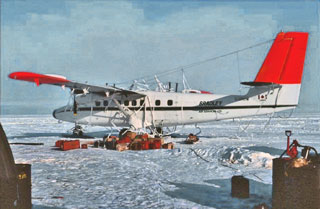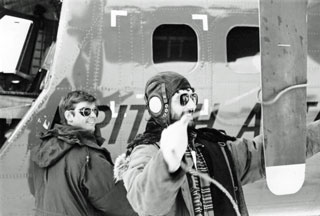More summer scenes
|
On 16 November there was bad weather at McMurdo which resulted in this rare scene--3 C-130's parked at Pole with engines shut down.  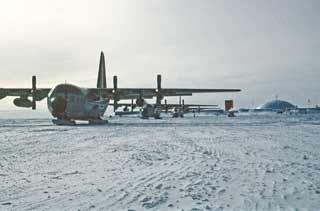 The flight crews took turns running an auxiliary power unit on at least one of the aircraft so that they could "jump start" the other aircraft and warm up their engines and electronics....What was the weather at Pole?? Well, the NOAA met data file for 1976 is missing (what gives Brad??) but it must have been calm and fairly mild since there is a light ice fog visible. My picture is at left; at right is Tadashi's view looking the other way.  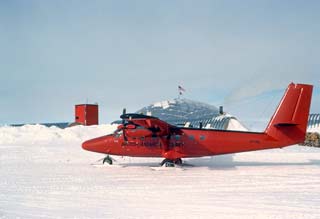
There were actually FOUR aircraft on deck at once, as you can see in the above left photo from the VXE-6 cruisebook. In addition to the LC-130's, we had a red British Antarctic Survey Twin Otter that was crossing the continent to support the Ross Ice Shelf Project (RISP). By the way, this aircraft left that project before the end of the season to rescue folks from another Twin Otter crash in East Antarctica. I'm not sure of the record for the number of aircraft on deck at Pole, but I do know that as of 1976 all of these airplanes and their crews and passengers presented a new record population for Pole--106!! That's a small crowd nowadays, but in our time it was a massive mess. People were sleeping EVERYWHERE! Since we also were still dealing with the Dome C acclimatization crowds and the new construction camp wasn't built, we did have lots of mattresses, bunk beds in the gym, and pilots sleeping on and under the pool table...the next day the aircraft were able to depart, although some of them required refueling.  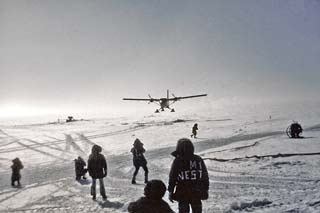
At left is summer GFA Dave Pluth standing in front of our other visiting Twin Otter. This aircraft was contracted out to NSF, also to support the Ross Ice Shelf Project, and the pilot was the late great Antarctic aviator Giles Kershaw. This was only his second season on the ice, but people at Pole already knew his reputation for being brash and bold. We didn't get to see that right away because the Pole weather turned foggy on his trip in, and he got lost and almost ran out of fuel... so after his landing he was timid and chaste for the first 30 minutes or so. However, he recovered quickly and buzzed us all a few times after he took off for the Ross Ice Shelf. Stu's picture at right is just one example...I cranked up the brightness and contrast a bit in an attempt to bring out as much detail as possible. | |
Sadly, Giles died in a solo gyrocopter crash on the then-Jones Ice Shelf on 5 March 1990. In the 1970's it was not feasible for light aircraft to transit from South America to Antarctica without official government sanctions, since they had to refuel at government-operated stations. Giles would rewrite those rules during the next decade. He was the pilot for the Transglobe Expedition (his light aircraft was transported by ship to the winter base south of South Africa) and he later would pioneer flights to blue ice runway sites for BAS, USAP, and the tourist airlines that eventually set up a base at Patriot Hills. 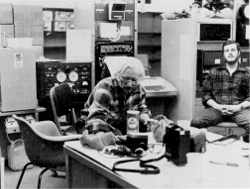 Pole has always been a popular spot to study isolated populations. Some of the research has been used to prepare for extended space flight, more of it has been used in endless attempts to help improve the selection process for w/o's. Of course all the research they did on us is obsolete now that there are women, internet connections, and other features of real world life. Anyway, in addition to the tests we all took before we went down, we got visited more than once, before and after the winter, by visiting teams of Navy and civilian psychologists who wanted to see just how weird we all were. NZ sent their own team down; here is a DSIR photo of psychologist Tony Taylor (L) interviewing Lloyd in the met office during the summer. Lloyd must have gotten all of the questions right (or wrong (?)) anyway they let him stay for the winter.
Pole has always been a popular spot to study isolated populations. Some of the research has been used to prepare for extended space flight, more of it has been used in endless attempts to help improve the selection process for w/o's. Of course all the research they did on us is obsolete now that there are women, internet connections, and other features of real world life. Anyway, in addition to the tests we all took before we went down, we got visited more than once, before and after the winter, by visiting teams of Navy and civilian psychologists who wanted to see just how weird we all were. NZ sent their own team down; here is a DSIR photo of psychologist Tony Taylor (L) interviewing Lloyd in the met office during the summer. Lloyd must have gotten all of the questions right (or wrong (?)) anyway they let him stay for the winter. | |
